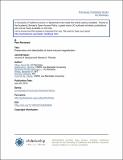Preservation and detectability of shock-induced magnetization
Author(s)
Swanson-Hysell, Nicholas L.; Cournède, Cécile; Tikoo, Sonia M.; Gattacceca, Jerome; Suavet, Clement Romain; Weiss, Benjamin P.; ... Show more Show less
DownloadWeiss_Preservation.pdf (1.460Mb)
OPEN_ACCESS_POLICY
Open Access Policy
Creative Commons Attribution-Noncommercial-Share Alike
Terms of use
Metadata
Show full item recordAbstract
An understanding of the effects of hypervelocity impacts on the magnetization of natural samples is required for interpreting paleomagnetic records of meteorites, lunar rocks, and cratered planetary surfaces. Rocks containing ferromagnetic minerals have been shown to acquire shock remanent magnetization (SRM) due to the passage of a shock wave in the presence of an ambient magnetic field. In this study, we conducted pressure remanent magnetization (PRM) acquisition experiments on a variety of natural samples as an analog for SRM acquisition at pressures ranging up to 1.8 GPa. Comparison of the alternating field (AF) and thermal demagnetization behavior of PRM confirms that AF demagnetization is a more efficient method for removing SRM overprints than thermal demagnetization because SRM may persist to unblocking temperatures approaching the Curie temperatures of magnetic minerals. The blocking of SRM to high temperatures suggests that SRM could persist without being eradicated by viscous relaxation over geologic timescales. However, SRM has been rarely observed in natural samples likely because of two factors: (1) other forms of impact-related remanence (e.g., thermal remanent magnetization from impact-related heating or chemical remanent magnetization from postimpact hydrothermal activity) are often acquired by target rocks that overprint SRM, and (2) low SRM acquisition efficiencies may prevent SRM from being distinguished from the underlying primary remanence or other overprints due to its low magnetization intensity.
Date issued
2015-07Department
Massachusetts Institute of Technology. Department of Earth, Atmospheric, and Planetary SciencesJournal
Journal of Geophysical Research: Planets
Publisher
American Geophysical Union (AGU)
Citation
Tikoo, Sonia M. et al. “Preservation and Detectability of Shock-Induced Magnetization: PRESERVATION AND DETECTABILITY OF SRM.” Journal of Geophysical Research: Planets 120.9 (2015): 1461–1475.
Version: Author's final manuscript
ISSN
2169-9100